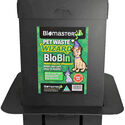Everyone goes, especially dogs
How to handle the problem at home with a pet septic system
July 22, 2021

Doggy Dooley®
One of the Doggy Dooley® products installed. The hands-free hatch opens with a foot-pedal for convenience.
I have owned dogs living in apartments and houses. My first dog, Tupac, a miniature dachshund, lived with me in an apartment in Seattle. Apartment life means no yard, so we would go for walks around the neighborhood and local dog parks. Walks were when he could do his "business." Unpaid, of course.
After Tupac found the perfect spot and checked his p-mail, I would pull out a poop bag, open it up, slip my hand in and pick up his gift-to-mom. I can't lie; that first bagful was a test of my love for Tuppy. It was lucky for him that he was so adorable.
It's been years since that first bag, and now I have two dogs, Wrecks and Monkey. I'm so accustomed to the process that not only do I pick up my dogs' waste; I pick up other dogs' abandoned poop as well. Not my favorite activity, but it is the neighborly thing to do.
I worry about the negative environmental impact of using plastic poop bags. The thought of filling landfills with bags of 'Wrecks's best' feels problematic. However, it is never an option to leave waste on the ground where untreated toxins can get into the watershed. If you do use poop bags, it is recommended to double bag waste before disposing of the waste in the trash.
Recently, I moved from my loft above Ten Ton Coffee to a house with a big, fenced yard. My dogs, Wrecks and Monkey, are now working remotely from home and do most of their 'business' in the yard. I don't need to use as many plastic bags, but I had to find a way to handle the clean-up at home.
Several options for handling pet waste at home are available. Some pet owners bury the waste, which should be at least one foot deep and not close to vegetable gardens. Depending on how big your yard is, you can quickly run out of space. Unfortunately, burying the problem risks contaminating the watershed.
Another option is flushing waste. If you are uncomfortable bringing the waste to a toilet straight from the yard, it can be bagged in flushable poop bags. It is important to make sure the home's plumbing can handle the bagged waste. Some products are designed to be connected to your home's sewer line directly, bypassing flushing and the need to bag. Again, make sure your system is compatible with these products. If your system allows flushable bags, your dog's waste will be processed at your local water treatment plant eliminating environmental issues. This is the best environmental choice for dog owners. It is important to remember that cat waste cannot be flushed as it may contain pathogens treatment plants cannot process.
Not trusting my sewer line can handle the job, I chose to install a pet septic system, specifically a Doggy Dooly. It is available from most pet supply stores and Amazon. This system is easily installed and simple to use. There are enzymes that are added to break down the waste. There are directions for DYI versions online; most use some sort of septic starter to break down waste.
It is recommended to do the following "perk test" at the location you are considering installing a septic system:
1. Dig a test hole approximately one foot wide by two feet deep.
2. Pour approximately five gallons of water into the hole.
3. Check the hole in 24 hours. If water is completely drained, you have moderately sandy soil, and the pyramid-style Doggie Dooley is recommended. If there is still standing water, check again after 48 hours.
4. If the water is gone, you can use either the tank style or pyramid style of Doggie Dooley.
If, after 48 total hours, there is still standing water in the hole, a dog waste septic system will not be an effective waste management system in that location of your yard. Test another site!












Reader Comments(0)